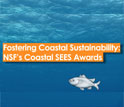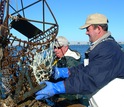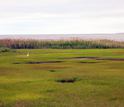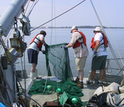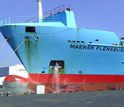News Release 14-122
NSF awards $15 million in second set of coastal sustainability grants
In wake of storms such as Hurricanes Sandy and Isaac, awards will lead to better management of coastal environments
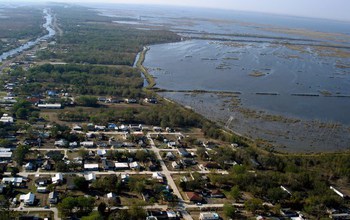
River management strategies affect flood risk for coastal communities.
September 15, 2014
This material is available primarily for archival purposes. Telephone numbers or other contact information may be out of date; please see current contact information at media contacts.
More than half the world's human population lived in coastal areas in the year 2000; that number is expected to rise to 75 percent by 2025.
If current population trends continue, projections are for the crowded U.S. coast to see its population grow from 123 million people to nearly 134 million people by 2020.
With our large footprint in coastal sands--and in the wake of severe storms such as Hurricanes Sandy and Isaac--how do we co-exist with our coastlines? How do we use them sustainably?
A sustainable world is one in which human needs are met equitably, without sacrificing the ability of future generations to meet their needs.
The National Science Foundation's (NSF) Coastal SEES, or Science, Engineering and Education for Sustainability, program is focused on the sustainability of coastal systems: the swath of land closely connected to the sea, including barrier islands, wetlands, mudflats, beaches and estuaries, as well as coastal cities, towns, recreational areas and maritime facilities; the continental seas and shelves; and the atmosphere above.
NSF's Coastal SEES program, supported by NSF's Directorates for Geosciences and Biological Sciences, has funded its second set of awards for studies of coasts in the U.S. and around the world. The awards total more than $15 million.
Coastal systems are crucial to regional and national economies. They host human-built infrastructure and provide ecosystem services that sustain our well-being, says Debbie Bronk, director of NSF's Division of Ocean Sciences.
"Our coastal waters are threatened on many fronts--increasing populations in coastal counties along U.S. coasts and in coastal nations around the world, nutrient runoff, overfishing and wetland loss, to name a few factors," says Bronk.
"The Coastal SEES awards bring together researchers with a range of expertise, such as ecology, engineering, economics and oceanography, to make advances in the understanding of these threats and how best to respond to them."
We need to better comprehend a realm with both human and natural influences, says Penny Firth, director of NSF's Division of Environmental Biology, so we might make better decisions about its future.
"This set of projects represents a key investment in fundamental research with immediate and long-term relevance to coupled human and natural systems in the coastal zone," says Firth. "Complexity and change are now recognized as the pervasive context for this important sustainability research."
NSF's new coastal SEES projects address topics such as salt-marsh persistence in response to sea-level rise, changes in coastal flood risks as a result of river management strategies, ship-borne introductions of invasive species, sustainability of coastal deltas such as the Huanghe Delta in China, and oyster fisheries in Chesapeake Bay: integrating stakeholder objectives with natural system models to promote sustainable policies.
They also focus on adaptations of fish and fishing communities to rapid climate change, biological and cultural resilience of coastal Pacific islands, the effects of restoration and redevelopment on nitrogen in an urban coastal watershed, and saltwater intrusion along the coastal plain.
2014 NSF Coastal SEES Awards
Ryan Emanuel, North Carolina State University: Coastal SEES Collaborative Research: Salinization of the Coastal Plain through Saltwater Intrusion - Landscapes in Transition along the Leading Edge of Climate Change
Peter Groffman, Cary Institute of Ecosystem Studies: Coastal SEES Collaborative Research: Effects of restoration and redevelopment on nitrogen dynamics in an urban coastal watershed
David Lodge, University of Notre Dame: Coastal SEES Collaborative Research: Changes in Ship-borne Introductions of Invasive Species in Coupled Natural-human Systems: Infrastructure, Global Trade, Climate and Policy
Karen McGlathery, University of Virginia: Coastal SEES Collaborative Research: A cross-site comparison of salt marsh persistence in response to sea-level rise and feedbacks from social adaptations
Jeffrey Nittrouer, William Marsh Rice University: Coastal SEES Collaborative Research: Morphologic, Socioeconomic, and Engineering Sustainability of Massively Anthropic Coastal Deltas: the Compelling Case of the Huanghe Delta
Elizabeth North, University of Maryland Center for Environmental Science: Coastal SEES Collaborative Research: Oyster fisheries in the Chesapeake Bay: Integrating stakeholder objectives with natural system models to promote sustainable policy
Malin Pinsky, Rutgers University: Coastal SEES Collaborative Research: Adaptations of fish and fishing communities to rapid climate change
Eleanor Sterling, American Museum of Natural History: Coastal SEES Collaborative Research: Understanding Coupled Biological and Cultural Resilience across Coastal Pacific Island Systems
Robert Twilley, Louisiana State University: Coastal SEES Collaborative Research: Changes in actual and perceived coastal flood risks due to river management strategies
-NSF-
-
View Video
A video interview about the coasts with Debbie Bronk, NSF Division Director for Ocean Sciences.
Credit and Larger Version -
Coastal SEES scientists are studying oysters to advance sustainable shellfisheries.
Credit and Larger Version -
Nutrients in urban runoff threaten coastal sustainability.
Credit and Larger Version -
Salt marshes buffer coastal communities from the effects of sea level rise.
Credit and Larger Version -
Coastal SEES researchers will study how fishermen respond to shifts in fish distribution, abundance.
Credit and Larger Version -
Ballast water pumped out of ships can spread invasive species.
Credit and Larger Version
Media Contacts
Cheryl Dybas, NSF, (703) 292-7734, email: cdybas@nsf.gov
Related Websites
NSF News: NSF awards first coastal sustainability grants: http://www.nsf.gov/news/news_summ.jsp?cntn_id=129266
The U.S. National Science Foundation propels the nation forward by advancing fundamental research in all fields of science and engineering. NSF supports research and people by providing facilities, instruments and funding to support their ingenuity and sustain the U.S. as a global leader in research and innovation. With a fiscal year 2023 budget of $9.5 billion, NSF funds reach all 50 states through grants to nearly 2,000 colleges, universities and institutions. Each year, NSF receives more than 40,000 competitive proposals and makes about 11,000 new awards. Those awards include support for cooperative research with industry, Arctic and Antarctic research and operations, and U.S. participation in international scientific efforts.
Connect with us online
NSF website: nsf.gov
NSF News: nsf.gov/news
For News Media: nsf.gov/news/newsroom
Statistics: nsf.gov/statistics/
Awards database: nsf.gov/awardsearch/
Follow us on social
Twitter: twitter.com/NSF
Facebook: facebook.com/US.NSF
Instagram: instagram.com/nsfgov



